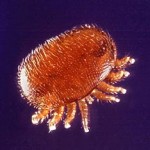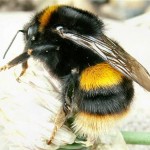
Emerging infectious diseases in honey bees have now been shown to spillover into bumblebee populations and may contribute to the worrying global decline in bumblebee colonies. In the UK alone, seven of the 25 native species of bumblebees are at risk and two of them are now extinct.
A great many of our crops, wild flowers and trees rely upon bees to pollinate them. In addition to honey bees, wild pollinators such as bumblebees play a large part in this beneficial behaviour, without which many crops would fail completely.
The news of bumblebee decline follows on from the widely reported loss of colonies of the honey bee, Apis mellifera, that have been reported in the past few years. Although several potential culprits have been implicated, including neonicotinoid insecticides, emerging infectious diseases appear to be two of the main causes of colony collapse in honey bees. In particular, a single celled organism, Nosema ceranae, and Deformed Wing Virus (DWV) have been associated with this decline.
Noseam ceranae has recently jumped host from the Asian honey bee to the Western honey bee and rapidly spread worldwide. It multiplies in the gut and infective spores are excreted with the faeces and contaminate the hive, and probably flowers visited by both honey bees and bumblebees alike.
Honey bees heavily infected with DWV have defective wings and, if they do not die at the pupal stage, are ejected from the hive. The ectoparasitic mite, Verroa destructor, acts as a vector for diseases known to be responsible for winter colony losses in Europe and has been shown to be a very efficient vector of DWV to honey bees.

The mite originated in South East Asia. It infests honey bee colonies and feeds on bee pupae and adults by sucking up the host haemolymph (blood), weakening the immune system and transmitting viruses in the process. DWV is found in far greater concentrations in mites than in the infected honey bees on which they fed and the virus may replicate in the mite, although this is contested.
Honey bees are traded worldwide and forage for pollen and nectar on the same sources as wild bumblebees, making disease transfer feasible. Last year Nosema was reported to infect bumblebees, reducing their survival by 48%. The study identified the miscosporidian parasite, Nosema in seven species of wild bumblebees, pointing to a spillover from honey bees to bumblebees.
To test the hypothesis that both DWV and Nosema are emerging bumblebee diseases, moving across from honey bees, researchers at Royal Holloway School of Biological Sciences (University of London) and their collaborators inoculated a common British bumblebee, B. terrestris, with both a complex of DWV and a similar virus, and Nosema. They confirmed that these pathogens were capable of infecting the bumblebees. Surprisingly, Nosemaand DWV were present in their control samples, but significantly more infections occurred in inoculated

bumblebees, and Nosema was found in fewer insects than DWV. Only the virus complex cause pathological symptoms; lifespan was reduced and offspring did not survive.
Field studies produced some evidence of hotspots for bumblebee infections with DWV clumping in the SW and E and Nosema in the SE of Britain. Their model showed a strong positive effect of infections in honey bees on bumblebee infection. Further data supported the likelihood of local transmission of virus between the two pollinators. They also surveyed honey bees and bumblebees from 26 sites in Britain and established that wild bumblebees were infected with the same strains of DWV as honey bees, though only 11% of the bumblebees were infected compared with 36% of honey bees.
The susceptibility of other species of bumblebee, or indeed other wild pollinators, to spillover of honey bee diseases is, as yet, unknown. If findings of this initial study, conducted in Britain, are representative of the global situation, it is likely that the presence of infected honey bee colonies could present a threat to bumblebees worldwide. Clearly more research to assess the extent of this problem and to improve the hygiene of managed colonies, in particular the control of Varroa, is needed or the flight of the bumble bee could be no more than a piece of well-loved music.

Comments